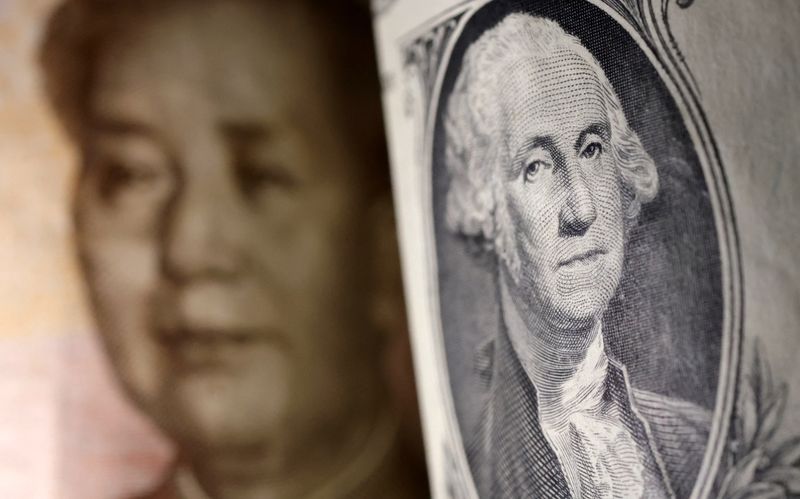By Himanshi Akhand
(Reuters) – Bearish bets on most Asian currencies rose to multi-month highs as prospects of fewer U.S. interest rate cuts this year continued to boost demand for dollars, while the threat of possible U.S. tariffs dampened the appeal of risky Asian assets undermined, according to a Reuters poll shown on Thursday.
Short bets on the Chinese yuan rose to their highest since June 2023, while those on the Malaysian ringgit and Indonesian rupiah hit seven-month highs, according to a fortnightly poll of 13 respondents.
The yuan, which has been trading near a 16-year low against the dollar, is seen as most vulnerable to a stronger dollar and tougher tariffs under the administration of newly elected US President Donald Trump.
China is also Southeast Asia’s largest trading partner and a weaker yuan could cause unrest in regional currency markets.
Ahead of Trump’s inauguration on January 20, markets have turned away from Asian assets as his policies around tax cuts, tariff increases and tighter immigration are likely to boost US prices, bond yields and the dollar.
Furthermore, the Federal Reserve’s projection of two rate cuts by 2025, half of what it previously estimated, has meant that markets have now fully priced in only one 25 basis point rate cut in 2025, with a 60% chance of a rate cut . second reduction.
Higher US interest rates and the dollar’s yield advantage could spur capital outflows into emerging Asian markets and weaken their currencies.
“The external environment may limit the extent to which Asian central banks can mitigate the weakness in Asian currencies since the start of the Fed austerity cycle,” DBS analysts said in a note.
The US central bank has cut interest rates by 100 basis points since September.
DBS added that there is a conflict between domestic and external priorities for Asia’s central banks and that less export-oriented economies may see lower volatility in prices.
Short positions on the Taiwan dollar were at their highest level since May 2024.
Bearish bets on the Indian rupee, which fell for a ninth straight week last week, were the highest since July 2022.
Short positions on the Singapore dollar were at their highest since October 2022.
“While Singapore could be directly protected from an escalation in US tariffs, it would still be significantly exposed to the indirect effects of slower global growth and spillovers from a slowdown in Chinese exports,” Citi analysts said.
Citi’s base case is that the Monetary Authority of Singapore (MAS) will ease policy in January due to recent disinflation trends and growth resilience issues.
According to the poll, the South Korean won is currently the most shorted Asian currency. 2024 saw the worst annual decline in 16 years, as government efforts to stimulate the market were overshadowed by signs of an export slowdown and domestic political unrest.
The Asian currency positioning poll focuses on what analysts and fund managers believe are the current market positions in nine Asian emerging market currencies: the Chinese Yuan, the South Korean Won, the Singapore Dollar, the Indonesian Rupiah, the Taiwan Dollar , the Indian rupee, the Philippine peso, the Malaysian ringgit and the Thai baht.
The poll uses estimates of net long or short positions on a scale of minus 3 to plus 3. A score of plus 3 indicates that the market is significantly long in US dollars.
The figures include positions via non-deliverable forwards (NDFs).
Below are the survey results (US dollar positions versus each currency):
DATE
09-Jan-25 1.65 1.75 1.34 1.20 1.18 1.69 0.99 0.65 0.76
12-dec-24 1.15 1.86 0.83 0.87 0.82 1.43 0.65 0.53 0.26
28-Nov-24 1.32 1.45 1.12 1.03 1.10 1.13 0.76 1.13 0.66
14-Nov-24 1.14 1.61 0.80 0.81 1.07 0.87 0.65 1.18 0.90
31-Oct-24 0.30 1.06 -0.03 0.59 0.60 0.82 0.11 0.81 0.09
17-Oct-24 -0.43 0.26 -0.44 0.04 0.24 0.67 -0.40 0.26 -0.28
03-Oct-2024 -1.14 -0.79 -1.26 -1.08 -0.59 -0.04 -1.18 -0.70 -1.45
19-Sep-2024 -0.67 -0.90 -1.12 -1.18 -0.66 0.33 -1.30 -1.10 -1.33

05-Sep-24 -0.85 -1.09 -1.26 -1.05 -0.77 0.21 -1.46 -1.00 -1.22
22-Aug-24 -0.62 -0.93 -1.08 -1.26 -0.70 0.21 -1.57 -1.03 -1.16


